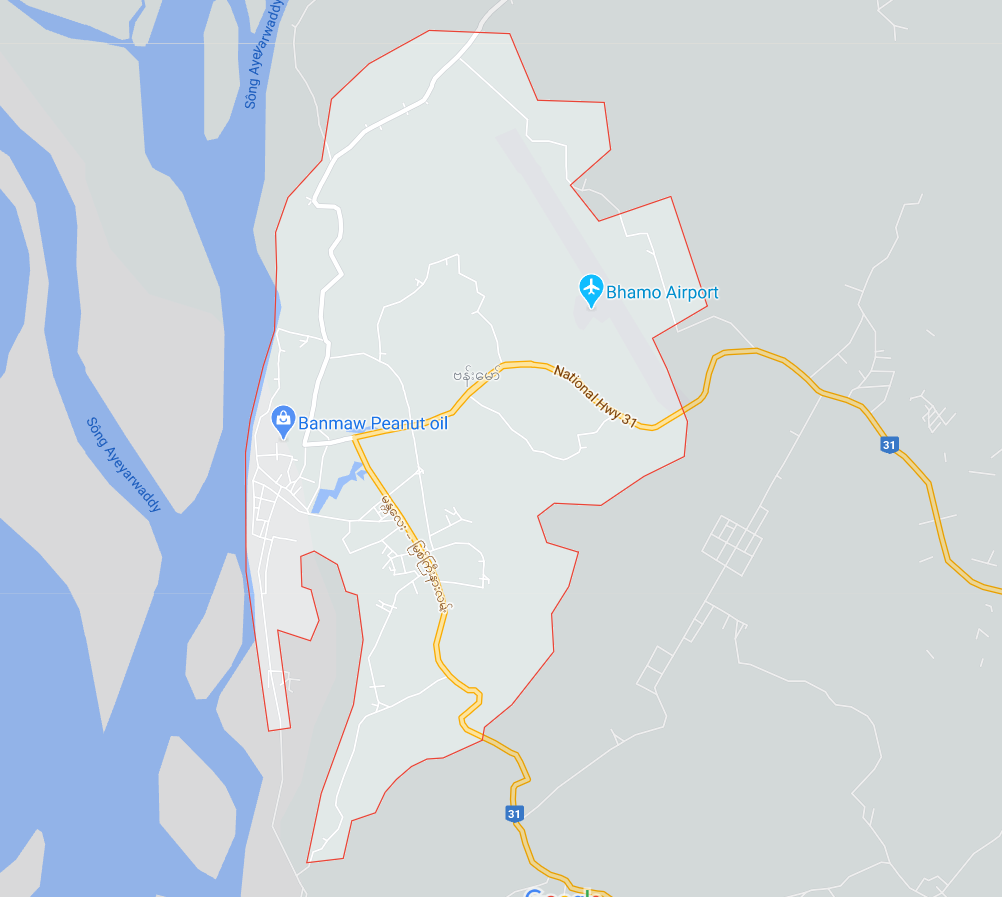Bhamo Guide - All you need to know
Bhamo is a city of Kachin State in the northernmost part of Myanmar, located 186 km south of the capital city of Myitkyina. The population consists of Chinese and Shan, with Kachin peoples in the hills around the town. It is the administrative center of Bhamo District and Bhamo Township.
Bhamo, also known as Banmaw, is a city located in Kachin State, Northern Myanmar. It is unique as a scenic and peaceful city, well-known for spectacular river cruises. Further embellishing the city are myriad ancient teak buildings, pagodas, and the famed Irrawaddy River.
The history of Bhamo
Bhamo was once the capital of the ancient state of Wanmaw and, later, of the Shan kingdom. Bhamo was officially incorporated into a united Myanmar in the 11th century. Bhamo has witnessed both glory and destruction throughout its turbulent history as a Chinese tributary town and, later, a British colonial administrative center. Today, the city remains a crucial terminus of both caravan and river trade routes between India and China, while holding historical values for the people of northern Myanmar.
Bhamo Myanmar map
Main attractions in Bhamo
- Shwe Kyina Paya Temple: Located 3 miles to the north of Bhamo is Shwe Kyina Paya, commonly referred to as the “golden pagoda of Bhamo.” Embellished by two gold-topped stupas, the pagoda also marks the historical site of Sampanago, the 5th-century Shan city. Significantly, the pagoda houses valuable information about the history of golden pagodas across Burma and continues to serve as an important spiritual pillar for Bhamo’s locals and tourists the world over.
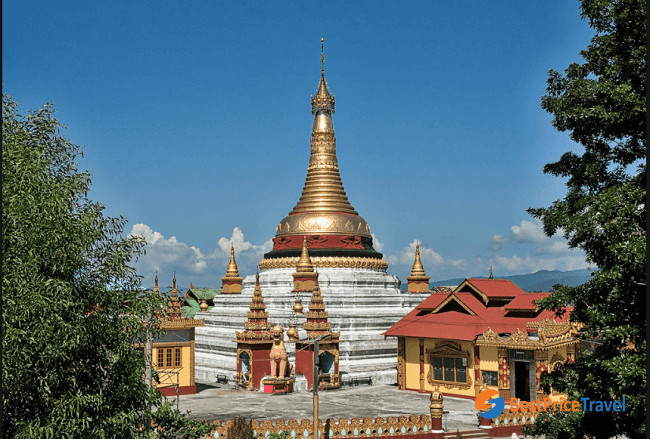
The Shwe Kyina Paya Temple
- Theindawgyi Pagoda: Located 4 miles from Bhamo, the Theindawgyi Pagoda is another famous attraction that the city has to offer. Theindawgyi is commonly believed to have been built by King Ashoka of India in the 3rd century BCE. In addition to housing a tooth relic of the Buddha himself, this pagoda is also home to a unique set of ancient monk statues that stand along a lotus pond. This spiritual and historical attraction is frequented by both locals and tourists, both Buddhists and atheist visitors who wish to learn more about Burmese and Thai Buddhism.
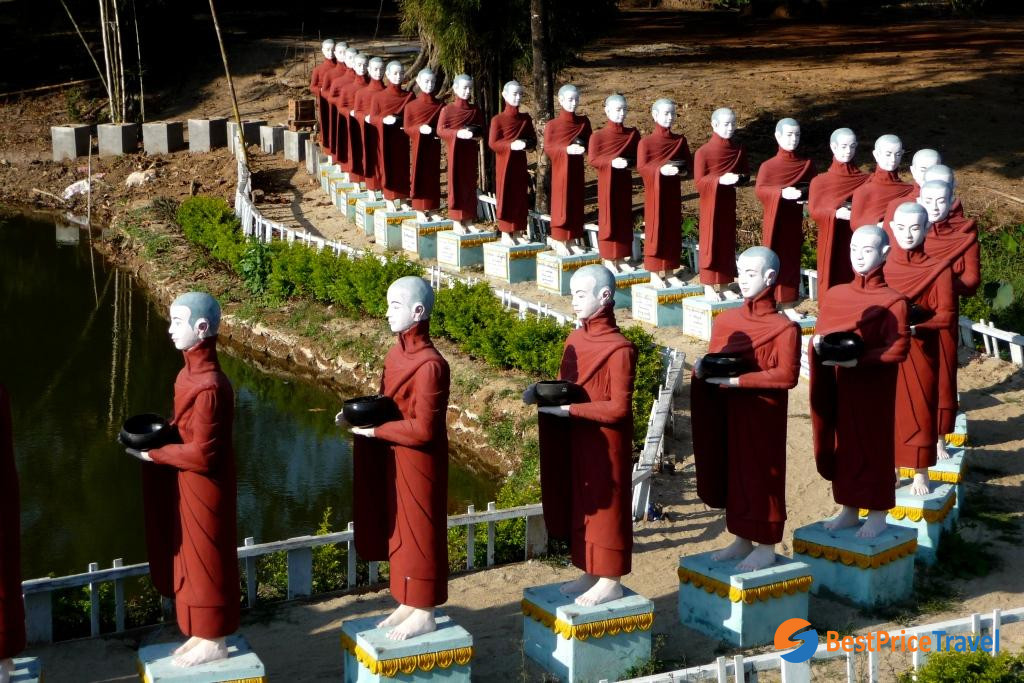
The Theindawgyi Pagoda
- Bhamo Harbor: After visiting Bhamo’s religious architectural gems, tourists may also want to stop by Bhamo Harbor. Vibrant with local life and fishing activities, Bhamo harbor is a perfect spot to enjoy the tranquility and beauty of nature. Sunrises and sunsets at the harbor are also among the most spectacular ones could find in Myanmar and elsewhere. As such, Bhamo harbor promises to offer a fantastic and memorable time to be spent either by oneself or with one’s friends, families, and loved ones.
- Bamboo Bridge: The Bamboo Bridge is another architecturally unique and must-stop attraction for tourists who visit the city of Bhamo. Located in the Wa Thatar village, this 5470-meter-long bridge is constructed entirely from bamboo, which gives it a rustic and naturally polished look. The bridge is crossed by countless villagers every day, as they leave their home for school, work, fishing, the market, and other daily activities. Despite having endured tremendous flooding every year and numerous reconstructions, as a result, the bridge continues to stand tall and reliably for Bhamo’s locals whose lives are intimately linked to this unique structure. Tourists may find walking on the bridge a tricky yet infinitely worthy experience. Not only does it allow tourists to feel and understand the daily life activities of Bhamo’s inhabitants, but the beautiful sight of the majestic mountains from afar also makes crossing the bridge a wonderful and memorable experience for those who dare try it. The bridge is best visited during the months of November, December, January, and February, in order to avoid the dangerous and debilitating flooding season.
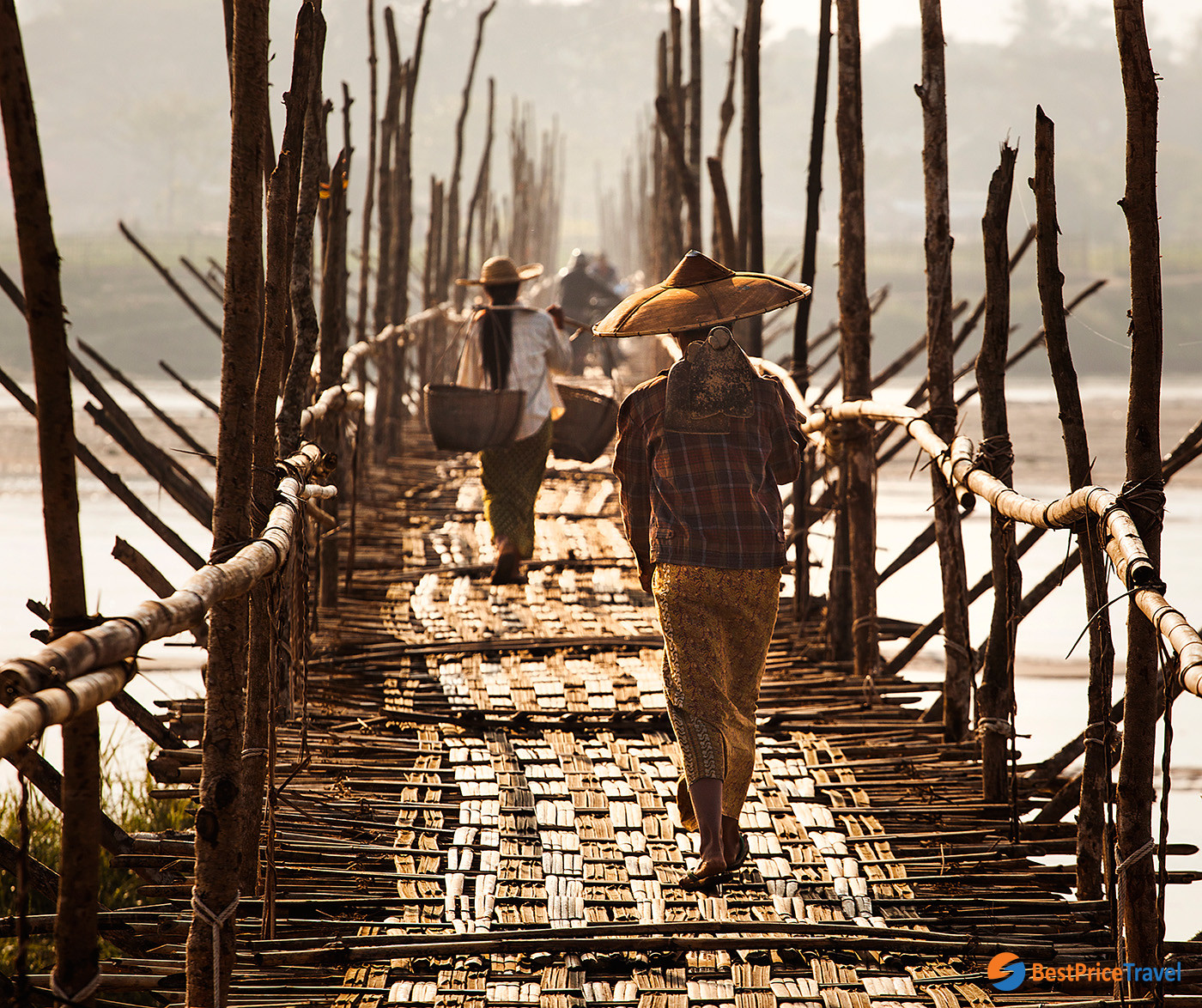
The Bamboo Bridge
- Irrawaddy River: Needless to say, the Irrawaddy river itself deserves recognition, for it not only provides livelihood for many local fishermen but is also a beautiful work of nature. Tourists are promised to have an enjoyable time while taking walks along the Irrawaddy river banks. There may also be short boat trips or river cruises offered by local boat owners, which can allow visitors the opportunity to fully enjoy the immensity and magnificence of Irrawaddy. As with the bamboo bridge, it is strongly recommended that visitors commit to these activities in the dry season to avoid dangerous floods and other potential extreme weather conditions.
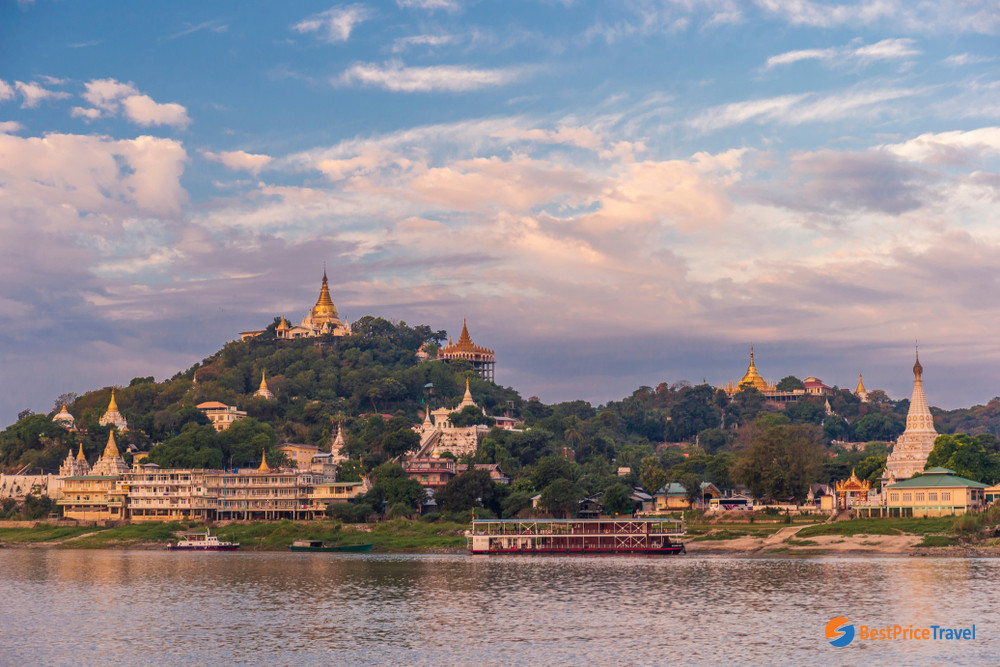
The riverbank of the Irrawaddy River
- Local Market and Restaurants: Finally, tourists will also want to visit Bhamo’s vibrant daily market and several local restaurants. Among the many amazing options, Shamie Restaurant and Sut Ngai Restaurant are the most recommended choices. These culinary gems offer must-try Burmese delicacies such as homemade tamarind chutney, curry, lime-flavoured pork served in banana leaves, and various delicious barbecued dishes. Also outstanding is Myanmar beer, which is available at any of these restaurants and local stores. Tourists may also buy souvenirs and local treats from Bhamo’s market, which is open every day.
Bhamo Cultural Features
Myanmar is a Buddhist country with many Buddhist temples and religious sites. Tourists should make sure to bring with them appropriate dressing attires, especially when they plan on visiting Bhamo’s different Buddhist pagodas. For instance, tourists must avoid sleeveless shirts, shorts, skirts, or pants that are shorter than the knee, and should try to wear toes-covered shoes rather than flip-flops. If planning on crossing the bamboo bridge, tourists should avoid long pants or long-sleeve shirts as these distracting clothes can make crossing the narrow bridge more challenging and dangerous.
Bhamo Weather
It is most recommended that tourists visit Bhamo during the months of November – mid-March when the weather is relatively dry and temperate. This dry season is especially essential when tourists plan on performing outdoor activities such as mountain climbing or traveling by boats.
The March-May period is too hot, which may leave tourists severely dehydrated. On the contrary, the August-October months are the region’s rainy season.
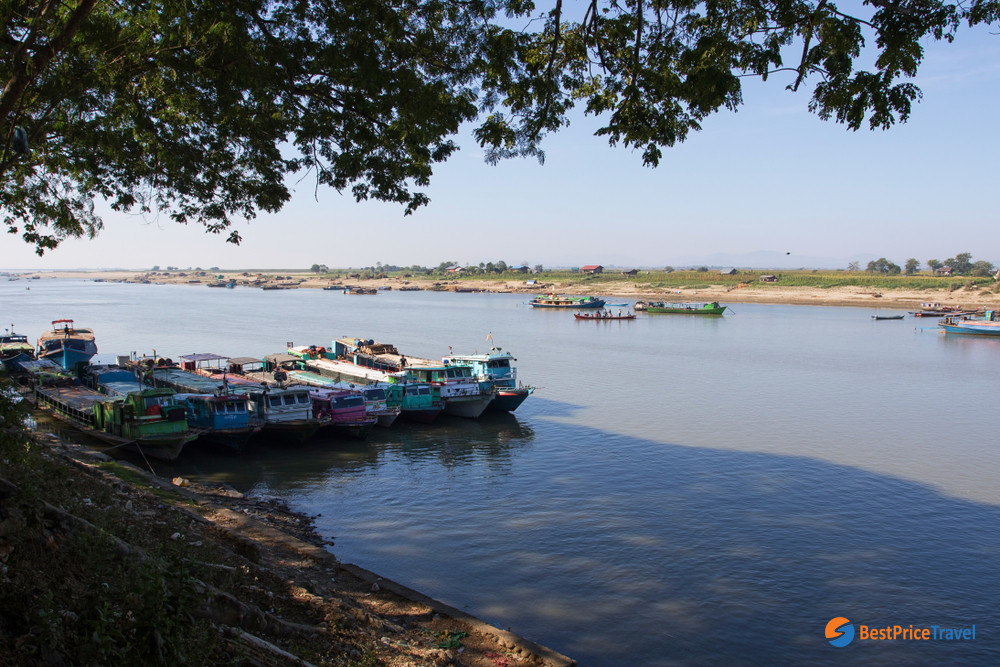
Boats docked at Bhamo jetty
Bhamo Transportation
Getting to Bhamo: Tourists can reach Bhamo either by flight from Mandalay or by boat from Katha.
- Flight: The first option usually means a once-a-week flight with Myanmar Airways to Bhamo Airport.
- Boat: There may also be river ferries available, around three times a week depending on the time of the year. These trips usually take between 1 to 3 days. Tourists can choose to purchase a ticket for a shared, two-bed cabin for approximately USD$60. If traveling from Katha, foreigners can take fast boats that take only 7-8 hours to arrive in Bhamo.
- Land travel: It is important to note that no over-land travel is permitted from either Mandalay or Katha to Bhamo.
Getting around Bhamo: The city of Bhamo is small enough to walk around. Tourists can also travel to and from the ferry by tuk-tuk, which costs around 2,000 kyats per person.
Travel Tips in Bhamo
Bhamo is a great place for both nature lovers and those who wish to pay homage to Buddhist temples and Burmese cultural and historical sites. These cultural and natural artifacts make wondrous pictures for amateur and professional photographers. Timing your travel is the most essential factor to ensure a safe, relaxing, and pleasant visit to Bhamo.
